Smart designing of revamping projects
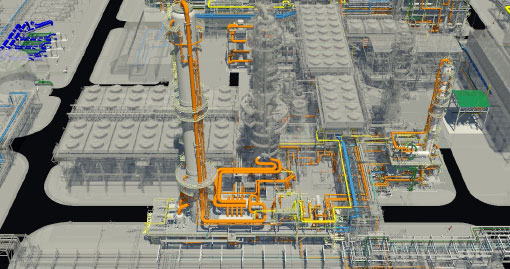
| Category | Chemical plant | ||||||||||
| Outline |
Design automation and integrated management using the smart plant program
|
||||||||||
| Key points |
SGC E&C minimizes design errors through computerization and interaction
of all design documents. Revamping projects for existing plants, aimed at physically expanding or improving their performance, are significantly more challenging than building new plants from scratch. SGC E&C collects information from existing plants and uses it to create 3D models, while accurately planning the scope of the new design and confirming the construction scope and material procurement through on-site verification. This process is meant to enhance the convenience of workers during the construction period and block any possible interference from the existing plant. |
||||||||||
| PJT Applied | SAFCO, IMC, YANSAB, NGU |
Smart designing of new projects
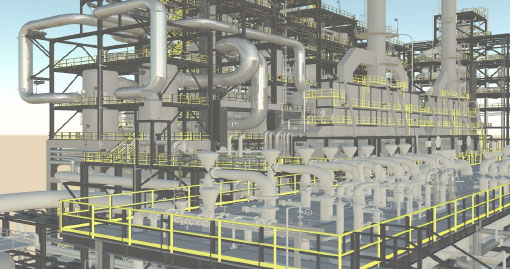
| Category | Chemical plant |
| Outline | Minimize design errors by applying 3D models to all projects |
| Key points |
SGC E&C resolves problems that may arise during construction by utilizing 3D
modeling to represent every design throughout the entire process in a virtual space. Shop drawings of steel structures, expansion bellows and spring supports for large pipes and equipment are all integrated into a single 3D file in real time. This enables us to facilitate rapid and accurate collaboration and confirmation of the design between different trades, and effectively prevent errors and omissions during the construction phase. |
| PJT Applied | PP4, PP5, OL1 |
Designing of pressure vessels, towers and heat exchangers using compressors
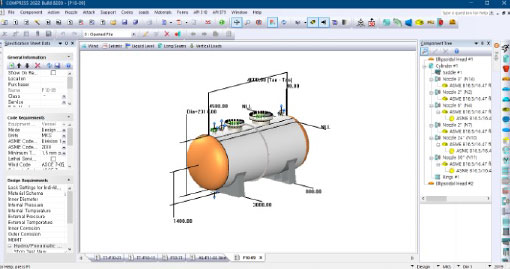
| Category | Chemical plant |
| Outline | Optimization of design for equipment (pressure vessels, towers, heat exchangers, etc.) using compressors to meet clients’ diverse demands |
| Key points |
SGC E&C possesses the expertise and capabilities for mechanical design required for projects, based on
its diverse experience in executing EPC for existing organic and inorganic chemical processes. In addition,
the company has a track record of CCU and bio-diesel projects that align with recent environmental-friendly trends,
as well as production processes for new materials and battery materials. We offer technical services with experienced mechanical engineers of diverse experiences while we are capable of providing swift responses to clients’ urgent needs, maintaining high quality and cost competitiveness at the same time. |
| PJT Applied |
CCU project Biodiesel – JC chemical project, B project Battery cathode material – S-3 project, HSPP project |
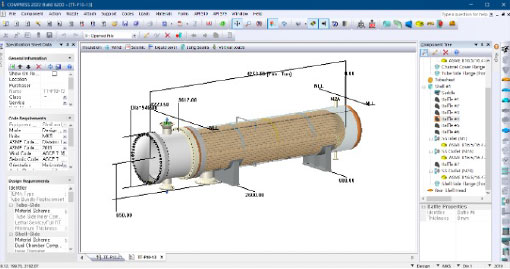
Designing of 3D-based structural analysis of plant
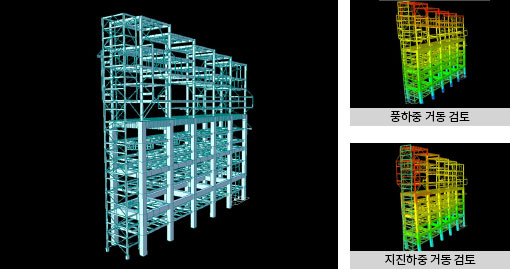
| Category | 3D structural analysis | ||||
| Outline |
Design structures of buildings and facilities based on 3D structural analysis
|
||||
| Key points |
SGC E&C ensures safety through 3D structural analysis mirroring the actual buildings and structures.
We perform structural design by taking into account the load factors based on the location and site
conditions of the structure being designed, as well as the characteristics of the mechanical equipment being used,
and the information on the structural components being utilized. We ensure structural safety by conducting structural force reviews that reflect all load conditions for each structural component based on a 3D analysis model. In addition, we perform simulation analysis for earthquakes and wind loads to prepare for natural disasters to ensure safety structures. |
||||
| PJT Applied | Buildings and structures in the chemical engineering, industrial and power generation fields |
Detailed review of buildings through 3D modeling
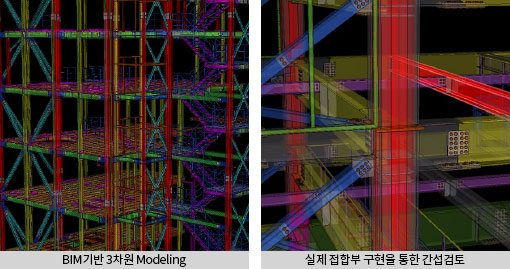
| Category | BIM-based smart design | ||||||
| Outline |
Detailed review of structural components through 3D modeling of buildings and
structures before construction
|
||||||
| Key points |
SGC E&C performs interference and joint reviews between structural components using BIM-based 3D modeling.
We perform 3D modeling based on the information in the drawings to minimize the interference between
structural components that may occur on-site. 3D modeling can prevent potential interference on-site. We review the optimal design based on the actual implementation of joint parts before the start of construction, customizing on-site variations. |
||||||
| PJT Applied | Steel structure buildings and structures in the chemical engineering, industrial and power generation fields |
Piping stress analysis
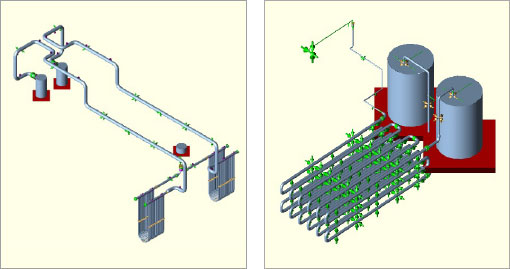
| Category | Chemical plant | ||||||||
| Outline |
|
||||||||
| Key points |
|
||||||||
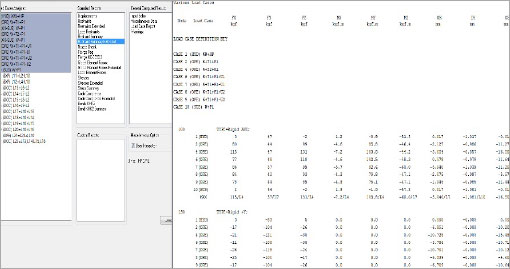
Designing of CCU using ASPEN+
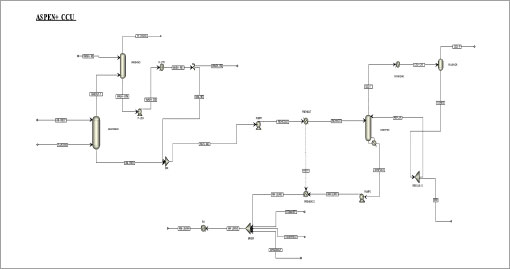
| Category | Chemical plant | ||||||||
| Outline | Process simulation using Aspen Plus | ||||||||
| Key points |
|
||||||||
| PJT Applied | CCU Project | ||||||||
| Intellectual property rights or patents |
KEPCO patented wet scrubber solvent: KoSol-6 |
ChemCAD
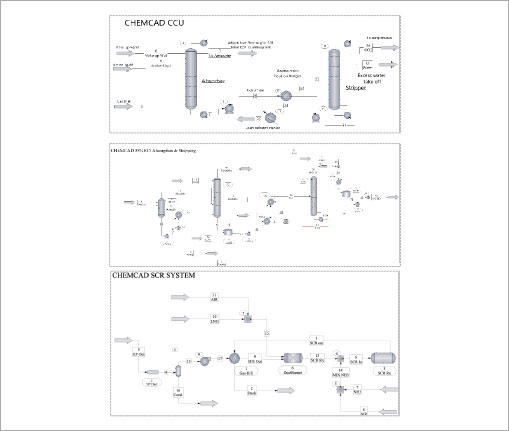
| Category | Chemical plant | ||||||||
| Outline | Process simulation using ChemCAD | ||||||||
| Key points |
|
||||||||
| PJT Applied | CCU, HCl Process, SCR System Project |
CCU(Carbon Capture & Utilization)
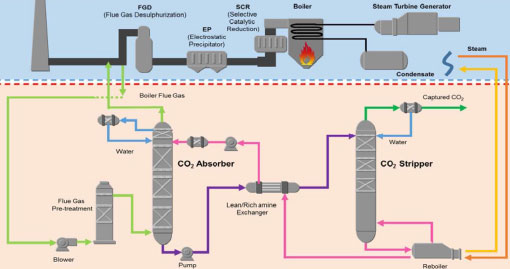
| Category | Power plant | ||||||||||||
| Outline |
In the final liquefaction facility, the CO₂ is compressed to over 20 BarG and then undergoes primary moisture removal in the cooler and chiller, and final moisture removal in the gel dryer. After that, it is cooled to -20°C in the CO₂ purifier to produce liquid carbon dioxide, which is then transferred to storage tanks and shipped out as L-CO₂ in tank lorries. |
||||||||||||
| Key points |
|
||||||||||||
| PJT Applied | 10MW pilot plant operation at the Boryeong Thermal Power Plant with a liquid capacity of 150 tons per day | ||||||||||||
| Intellectual property rights or patents |
KEPCO patented wet scrubber solvent: KoSol-6 |












